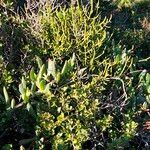Dioecious, stem parasite, up to 0.5 m tall, internodes of distal branches (6-)8-12(-15) x 2-3 mm. Leaves scale-like. Inflorescence unisexual. Berry sessile, smooth, white and watery.
A plant that grows attached to shrubs. It is 50 cm long. The stems are rounded. The leaves are scale like. The fruit are smooth white berries. They are 3-4 mm long.
Dioecious stem parasite to 50 cm. Leaves scale-like. Inflorescences unisexual. Berries sessile, smooth, white.

